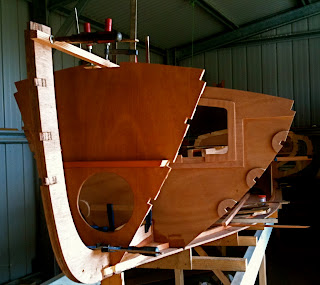 Having established the bottom rocker shape and fitted the keelson, the structure to support the cockpit bulkheads is attached to the floor and to the cockpit seat front panels. Transom has been glued too.
Having established the bottom rocker shape and fitted the keelson, the structure to support the cockpit bulkheads is attached to the floor and to the cockpit seat front panels. Transom has been glued too. Bulkheads 1 and 2 are glued and the whole thing looks most unlikely for a boat...that's part of the joy actually- the transformation of a kit of complicated parts into sub-assemblies, and the combination of these into , well, assemblies...and the cumulation of assemblies into bits of a boat- and on the way there are some lovely curves, and pleasant views through holes, not to mention some haunting cast shadows.
Bulkheads 1 and 2 are glued and the whole thing looks most unlikely for a boat...that's part of the joy actually- the transformation of a kit of complicated parts into sub-assemblies, and the combination of these into , well, assemblies...and the cumulation of assemblies into bits of a boat- and on the way there are some lovely curves, and pleasant views through holes, not to mention some haunting cast shadows.
The whole method of plywood boat building is in a way the total antithesis of the methods I use and love in traditional violin making. Where traditionally we deal with moisture and rot and fungus and swelling and movement and shrinkage by making sacrificial joints and using only organic reversible glues, and vapor-permeable coatings, and grain-orientation selected for stability- in modern plywood boats we use encapsulation within an epoxy (plastic) skin to keep moisture and it's associated problems permanently locked out, and alternating grain in the ply to keep things from changing size and shape in response to its exposure to the weather. The major benefit of this technology is that it enables us to keep boats in or out of the water without causing the sort of problems that traditionally built hulls suffer from. In short- we can keep them in a shed without them shrinking and leaking when they go back to the water.
No comments:
Post a Comment